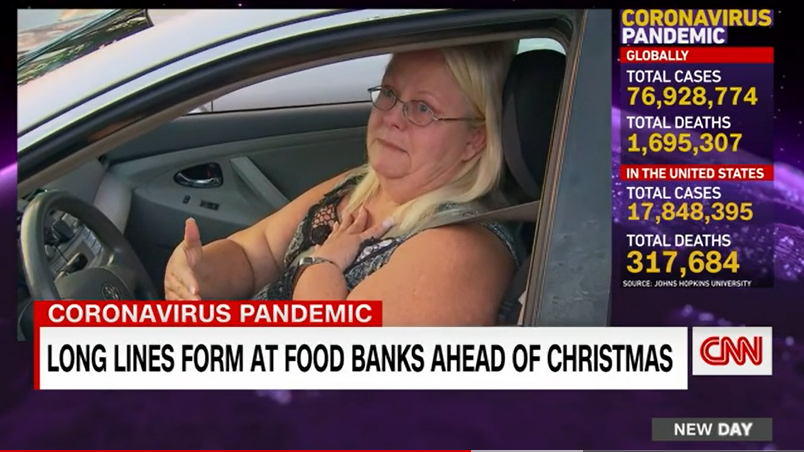Most of the people had arrived in the pre-dawn hours to receive the offerings from a local food bank. Some of the drivers and passengers slept in their cars.
“(They) have got to be desperate to come sit for almost five hours to get a box of food for their family,” Hightower said. The 57-year-old accountant and mother of three teenagers was recently hospitalized and says she lost her job twice since March. On the Saturday before Christmas, her eyes welled up — not over her grim reality, but from seeing the bumper-to-bumper need all around her.
“I would hate for me to get the last of something,” she said. “And the person behind me be in a worse position than I am.”
It’s a scene replayed in cities across the country as hunger skyrockets while the pandemic threatens lives and livelihoods. Feeding America — the largest domestic hunger-relief organization in the US — reports a 60% increase in the number of people asking for food assistance compared to last year.
Lack of access to food from coast-to-coast
Feeding America defines
food insecurity as “a household’s inability to provide enough food for every person to live an active, healthy life.”
Among the states with the highest food insecurity rates — between 20% and 22.6% of households — are Mississippi, Arkansas, Alabama and Louisiana, according to Feeding America. They are followed by Nevada, Michigan, New Mexico, Oklahoma, Texas and Kentucky, where between 18% and 19% of households lack access to food.
Systemic inequities in Latino, Black, Native American and minority communities across the country have only compounded during the pandemic, as unemployment rates and Covid-19 infections soar.
In Doraville, Georgia, a food distribution was organized to provide assistance for the area’s hard hit Latino community on the Saturday before Christmas.
Five hundred cars filled the old Kmart parking lot and dozens of people — mostly women with children — waited on foot in the cold to collect a 20-pound box of free food filled with fruit, vegetables, meat and chicken.
“This is an indication of the pain and suffering that’s being felt across the nation,” said Michael Thurmond, CEO of DeKalb County government. “We are all in this together, regardless of race, color, creed.”
Neighbors helping neighbors
In South Florida, one in five people don’t know where their next meal will come from, according to
Feeding South Florida. That’s over 1 million people, including nearly 300,000 children.
Some of them waited in line at the Boynton Beach Mall parking lot. But with their pride and dignity drained from losing jobs, few of them wanted to share their personal stories of struggle. Many of the ones willing to talk said they were not there to pick up food for themselves.
Larry Battisti, 76, said he was picking up food for three members of his church who are either unemployed, working part time or too concerned about Covid-19 to leave their homes.
“I take the time to do it because I love the people that I do it for,” Battisti said.
Julie and Leonard Thompson, a retired couple wearing Spiderman face masks, got in line at 4:30 a.m. and will take the groceries to seven neighbors and friends who are elderly, bedridden or moms with young children.
“Even if we don’t have much, we can still share with them,” Julie said.
The Thompsons don’t do it for the praise. One of their neighbors, Ibis Torres, a medically disabled woman in her 50s, can’t communicate with them because she only speaks Spanish. But she was all smiles and said “thank you” when they delivered chicken, juice and protein shakes to her door.
As they walked away, Torres described her neighbors as practically angels dropping help from heaven.
Surging demand and diminishing supply
More and more, people are being forced to rely on the kindness of others because Florida’s tourism, hospitality and retail industries have taken a huge hit.
“The need in South Florida is overwhelming,” Sari Vatske,
Feeding South Florida‘s executive vice president, told CNN. “It’s more than double what it was pre-Covid. We’ve never seen anything like this, and we’ve been in food banking for 40 years.”
Between March and November, Feeding South Florida provided over 150 million pounds of produce, meat, milk and other food to area residents.
A long-sought stimulus deal reached by Congress on Sunday provides money for the nation’s food supply and nutrition assistance. But in the short term, the demand for free food is expected to remain high.
“We’re nine months into this and we’re still seeing the same scenes that we saw, so long ago,” Vatske said. “It’s heartbreaking.”
‘Things have cascaded’
For the people who watched the sun rise at Boynton Beach Mall, the line of cars snaking around the parking lot confirmed what they feared: The need for food is growing.
The makes and models of the cars — which included Mercedes-Benz, Cadillac, Infiniti and Volvo — show the pandemic is not just hurting the poor. The middle class is vulnerable too, with some people waiting in food lines for the first time.
“Things have cascaded,” Battisti said. “I don’t think this society really knows how bad off people are at this point in time.”
The Thompsons agree. This holiday they plan to not only deliver food but also children’s gifts.
“People are without work (and) things are tough physically, financially, even emotionally,” Julie Thompson said.
Deborah Hightower counted her blessings as her trunk was filled with apples, beans, eggs and chicken.
“I pray that everybody gets what they need for Christmas,” she said.
By Rosa Flores, Denise Royal and Sara Weisfeldt, CNN
Originally aired and published by CNN on December 21, 2020. Click here for original article.

